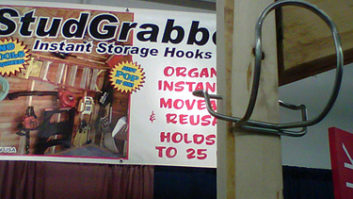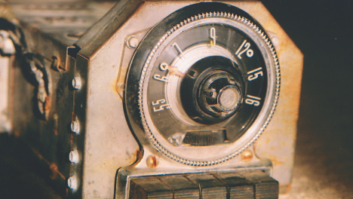The recent rash of transmitter site break-ins has gotten readers’ attention. Cell towers as well as broadcast facilities have been involved. Damage reports run the gamut: holes drilled in generator oil and fuel filters; the disabling of other stand-by equipment, or of building alarms; wires ripped from punch blocks; all breakers thrown to OFF; even removal of the station log book or technical manuals. Most of the break-ins have been on the weekend or on holidays, usually between midnight and 6 a.m.
Bob Clinton with the consulting firm Cavell, Mertz & Davis posted good information for his local SBE chapter. Should your site experience a “middle of the night” failure, keep these tips in mind:
It goes without saying, but we’ll say it anyway, that if you go off the air on a weekend or in the middle of the night, call a local authority to assist you in visiting the site.
Now is a good time to make friends with your local police precinct or sheriff. Why not drop off station T-shirts, caps or key chains to help generate good will?
Make plans now so that you can always bring a second person when you visit a site, especially if it is in the middle of the night, in response to going off the air.
You should have some kind of security system installed at the transmitter site that at least monitors unauthorized entry. Read on for a cheap means of achieving that end.
Bob Clinton can be reached at [email protected].
. . .
Lamar Smith, engineering manager for Entercom’s Scranton, Pa., cluster, is a frequent Workbench contributor. Lamar has just the answer for engineers looking to monitor their transmitter sites inexpensively.
(click thumbnail)Use your remote control to monitor site entry.
Frustrated with false alarms from security companies, Lamar bought sets of magnetic switches from Radio Shack and installed them on his transmitter site doors. The switches are tied into his remote control equipment and are set to alarm if broken. An alarm has been programmed into the remote control to dial Lamar’s pager.
With multiple sites, it’s not uncommon to receive several pager alarms as he or his engineers visit sites during the day. Nighttime alarms are another story. They shouldn’t occur, but the remote control is ready to send its notification should a door contact trip. The process is silent and cannot be disabled, as the switches are on the inside of the doors. It does not rely on a security company.
The system is not vandal-proof; if the telco or T-1 lines are cut, the system won’t work. But it is better than nothing.
Lamar Smith can be reached [email protected].

. . .
E. J. Knight is a CPBE with KTAR(AM) in Phoenix. Regarding our column on locking fences, E. J. offers a suggestion.
Depending on the type of gate is involved, and whether you are using a chain or a metal gate, you can weld two flanges to any two parts of the gate opening. The flanges should have a diameter with opposing holes sufficient to accept a “shrouded” type Master lock. Such a lock does not expose any of the “shank” portion of the mechanism. This is the portion that is generally cut.
For more information on the various shrouded locks, go to www.masterlocks.com Under Products, open the Group field and scroll to “shrouded padlocks.”
(click thumbnail)Barbed wire adds additional protection. But check local statutes first.
If you’re planning site security, check with your local lock shop or locksmith. Good ones have many creative suggestions for the gate, as well as site security. It costs nothing to ask.
E. J. Knight can be reached at [email protected] .
Sam Roffe, an engineer for KBCS(FM) in Belleview, Wash., offered similar suggestions. He adds that there are locks that are almost impossible to cut, though expensive. Check with a local locksmith. Also ask them to provide an SBE program on site security. The locksmith company may well pick up several new clients; and the suggestions will be helpful for the engineers in attendance.
Sam can be reached at [email protected].
Some engineers have topped their fences with razor wire or barbed wire. A cautionary note: Check with local statutes before proceeding. Some jurisdictions prohibit razor wire. Find out before you make the investment.

. . .
Les Proctor is with KNEB(AM/FM) in Scottsbluff, Neb.. Les would like some feedback from Workbench readers to solve a problem with generators and UPS systems.
Les writes that the stations purchased propane-powered generators with automatic transfer switches for both the studio and transmitter sites. As a part of the installation, UPS units were included for computers and other critical broadcast equipment.
The expectation was that the UPS’s would protect the computers and critical equipment, and maintain uninterrupted power for this equipment during the half-minute or so between utility power failure and the generator getting online.
For short power outages, the system works flawlessly.
Unfortunately, the UPS units will not accept the generator power, due to the distortion of the sine wave output of the generators. Ironically, the distortion is caused in part by the uninterruptible supplies themselves, because they are non-linear loads. This means that the UPS’s continue to run on batteries, even though the generators are successfully powering non-UPS “protected” equipment. Since the UPS will not accept the generator power, they will run only until their batteries run down.
The makers of the generators and UPS’s have suggested loading the generators with as many “clean” (linear) loads as possible, adding isolation transformers, or adjustable input UPS’s.
They have yet to find a practical solution to the problem, and therefore request suggestions for cleaning up a generator’s output so that the UPS is “happy” with it.
Write and tell us your ideas to [email protected]. Les Proctor can be reached at [email protected].
. . .
(click thumbnail)Every engineer needs a copy of the free Clark Pin Out Book.
Jeff Rosenberg runs Modulation Magic, a broadcast engineering project and solutions company near Boston. At the recent Boscon trade show, Jeff was offering a neat pinout booklet, prepared by Clark Wire and Cable. It gives a quick reference guide to standard pin-outs.
Also covered is an explanation of normalled and half-normalled patchbay wiring, all the typical audio connectors, as well as pinouts for 9- and 15-pin Sub-D connectors, as well as modular plug wiring. The resistor color code is also included, along with a number of humorous mnemonics to remember the colors.
As Sue Clark writes in the preface, this is a “must have” for your back pocket or toolbox when handling a wiring project. And remember, B-efore B-ad R-atings O-vercome Y-ou, G-o B-uy V-ery G-ood W-ire!
For your copy of the Clark Pinout Book, send a request to [email protected].
Submissions for this column are encouraged, and qualify for SBE recertification credit.












